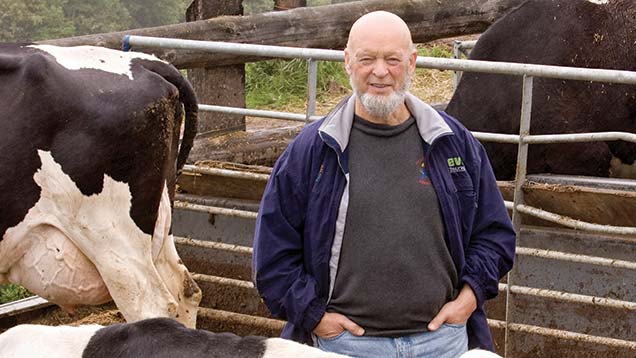Glastonbury Festival farmer’s secret to high milk yields and fertility
 © Jonathan Page
© Jonathan Page Bird proofing housing and sticking to routine are just some of the reasons the RABDF NMR Gold Cup winning herd of Glastonbury Festival organiser Michael Eavis is able to hit yields of 12,535 litres while maintaining good levels of fertility, reports Aly Balsom.
To produce yields of 70 litres a day, each cow at Worthy Farm, Pilton, is running the equivalent of two marathons every day.
With such huge demand placed on cows, the farm team places huge emphasis on ensuring every aspect of herd management is geared toward maximising intakes in as stress-free environment as possible.
Herd managers John Taylor and wife Pam believe routine is one of the most important factors in ensuring cows hit top yields while remaining fertile.
“You almost have to bore cows to death. It’s about routine and sticking rigidly to 12-hour milking…and we religiously feed at the same time every day,” said Mr Taylor at the recent Gold Cup Farm Walk at Worthy Farm, Somerset.
See more: Achieving high yields using a robot
The 387-cow Holstein herd is milked twice a day and averages 12,535 litres a cow a year at 3.8% butterfat and 3.2% protein.
Despite such high yields fertility is uncompromised, with the herd achieving 1.95 services to conception, 52% holding to first service and a 400-day calving interval. Farmer Michael Eavis said feeding a balanced ration was fundamental to cow performance.
“It’s about the whole feeding regime. The quality of the grass and maize silage is so important, as is ration balancing,” he told Farmers Weekly on the Pyramid Stage, where Dolly Parton entertained festival goers last year.
Ration balance is particularly crucial considering the herd is receiving a glucogenic diet comprising grass and maize silage, hay, a blend, compound, moist feed, minerals and yeast together with concentrate through the parlour.
A glucogenic diet is designed to deliver high-starch, which will ultimately be converted into glucose and then lactose in the udder. This lactose is key in drawing in water to the udder to produce milk.
Nutritionist Alison Boydell from ForFarmers explained that careful rationing was important to maintain a healthy rumen and liver.
“Too much starch in the rumen depresses pH so you need to balance the ration so the rumen bugs work effectively. We feed buffers and yeast to the cows to push starch without upsetting rumen function,” she explained.
Herd rumen fill, cudding rates, fertility and milk fatty acid levels are also monitored closely to ensure cows are being rationed effectively. Ms Boydell said the fact cows had good access to feed and 0.7m of trough space an animal also helped achieve dry matter intakes of 27.5kg a day, which ultimately drove yields.
Mr Taylor explained keeping troughs clean was also an important part of farm routine. “It only takes 10 minutes to clean all the troughs out with a shovel every day. You don’t want anything mouldy at the bottom as that will impact on intakes and yields,” he said.
However, of all the steps taken on farm he believes starling proofing the sheds had been the most significant. A few years ago, the starling problem had got out of hand with huge flocks causing significant contamination issues, leading to several cows dying of Salmonella. As a result, the farm invested £24,000 to wire mesh the entire building.
“We saw a three litre a cow a day increase just from the netting, let alone the benefits from reduced vet costs and cow losses and the fact it’s now a pleasure to work in the sheds,” said Mr Taylor.
Having started breeding their own heifers about eight years ago, the ongoing breeding strategy is also geared towards producing highly productive, fertile, long lived cows.
The farm now uses 100% genomic bulls on cows, with sires sourced from the US. To spread risk, about 10 bulls are used every a year with sires selected for milk, productive life and good daughter pregnancy rates.
“We’ve gradually increased the number of genomic sires we use as we’ve become more confident. I felt genomics was an opportunity not to be missed as you’re getting the best young sires straight away,” said Mr Taylor.
Along with breeding, Mr Eavis also believes cow comfort is fundamental to success. And by providing 500 cubicles for 400 cows the team is ensuring every cow gets to lie down for 14 hours, thus maximising the potential for milk production.
“The main success factor (to producing high yields) is a content cow that’s in a comfortable environment,” said Mr Eavis.
